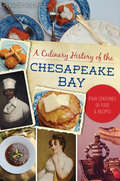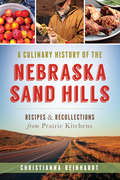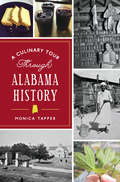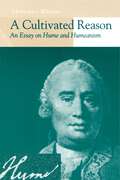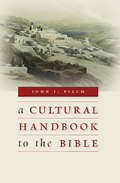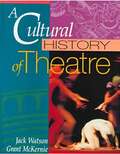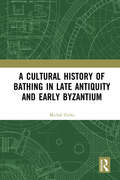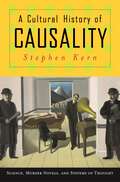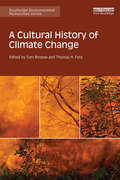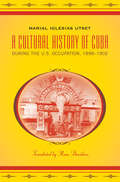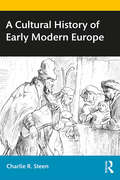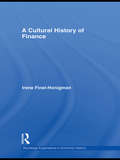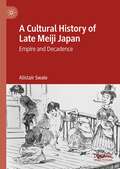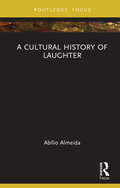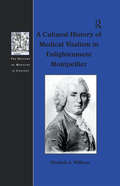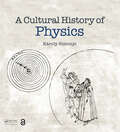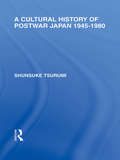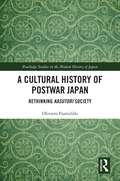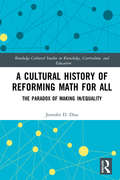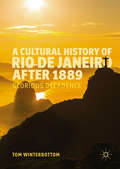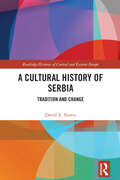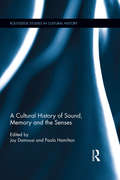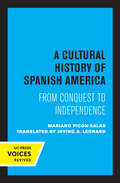- Table View
- List View
A Culinary History of the Chesapeake Bay: Four Centuries of Food & Recipes (American Palate)
by Tangie HolifieldThe four hundred years since colonization have brought European, African and Asian techniques, ingredients and tastes to the Chesapeake Bay. European colonists and Africans both enslaved and free were influenced by indigenous ingredients and Native American cooking and created uniquely New World foods. The nineteenth century saw the development of industries based on the bounty of the Bay and the rising popularity of oysters, blue crab and turtle soup throughout the greater Mid-Atlantic. Waves of immigrants brought their own cuisines to the mix, and colcannon, brisket, sauerkraut and fish peppers are now found on Chesapeake tables. Local author, scientist and blogger Tangie Holifield weaves together the unique food traditions of the Bay, telling the stories of each culture that has contributed to its bounty.
A Culinary History of the Nebraska Sand Hills: Recipes & Recollections from Prairie Kitchens (American Palate)
by Christianna ReinhardtSpanning nineteen thousand square miles of central Nebraska, the Sand Hills--North America's largest sand dune--is held in place by only a thin, sturdy layer of native prairie grasses and continuing faith that the land can be made prosperous by its residents. Settlers in the area had to be hardy and resourceful, making use of what the land provided and holding fast when their hard work blew away with the prairie winds. From foraging to ranching, food meant survival, but it also meant community. Staples like fried chicken, biscuits, fruit pies, preserves and cakes all play a role in the fascinating story of the region. Join food writer Christianna Reinhardt as she dishes up the unique and tasty history of this exceptional part of the world.
A Culinary Tour Through Alabama History (American Palate)
by Monica TapperOne of the surest ways to connect with the past is to sample what was on its plate. That's the goal with this gustatory journey through Alabama history. Sweetmeats with the governor's lonely, oft-depressed wife in 1832 Greensboro. Shrimp and crabmeat casserole at a long-departed preacher's house at the Gaines Ridge Dinner Club in Camden. Pimento cheese and tea with notes of cinnamon and citrus at the Bragg-Mitchell Mansion in Mobile. Poundcake from Georgia Gilmore's kitchen in Montgomery, where workaday freedom fighters and luminaries of the civil rights movement sought sustenance. Author Monica Tapper serves up a stick-to-your-ribs trek through Alabama history, providing classic recipes modified for the modern kitchen along the way.
A Cultivated Reason: An Essay on Hume and Humeanism (G - Reference, Information and Interdisciplinary Subjects)
by Christopher WilliamsAs Plato’s tripartite division of the soul, Descartes’s criterion of clear and distinct ideas, and Kant’s notion of the categorical imperative attest, philosophy has traditionally been wedded to rationalism and its “intellectualist” view of persons. In this book Christopher Williams seeks to wean his fellow philosophers away from an overly rationalistic self-understanding by using resources that are available within the philosophical tradition itself, including some that anticipate strands of Nietzsche’s thought.The book begins by developing Hume’s critique of rationalism, with reference especially to the section of the Treatise that deals with the continuing existence of bodies (an argument that subverts intellectualist criteria by attempting to satisfy them) and to his neglected essay “The Sceptic” where Hume reveals the importance of our embodiment through a comic portrayal of philosophers’ efforts to “correct our sentiments.” Then it moves on to ward off charges of irrationalism by showing that, although our powers of self-correction are more limited than the rationalist thinks they are, a Humean position is able both to sustain a commitment to reflection and to sensitize us to a version of irrationalism, manifest in monotheistic theologies, that is otherwise difficult to detect. The book concludes, more speculatively, with a comparison of persons to artworks in order to show how our aesthetic dimension is the source of some of the normative work previously assigned to rationalist reason.Ranging as it does across subfields from epistemology and history of philosophy to ethics and aesthetics, A Cultivated Reason should appeal to a wide audience of philosophers and to scholars in other fields as well.
A Cultural Handbook to the Bible
by John J. PilchThe task of interpreting the Bible — which was written by and to people living in very different cultural contexts from contemporary Western society — can seem monumental. The opposite is also true: people can easily forget that studying the Bible is a type of cross-cultural encounter, instead reading their own cultural assumptions into biblical texts.In A Cultural Handbook to the Bible John Pilch bridges this cultural divide by translating important social concepts and applying them to biblical texts. In short, accessible chapters Pilch discusses sixty-three topics related to the cosmos, the earth, persons, family, language, human consciousness, God and the spirit world, and entertainment. Pilch's fresh interpretations of the Bible challenge traditional views and explore topics often overlooked in commentaries. Each chapter concludes with a list of useful references from cultural anthropology or biblical studies, making this book an excellent resource for students of the Bible.
A Cultural History Of Theatre
by Jack Watson Grant McKernieThis comprehensive, multicultural text presents the history of theater within a framework of cultural and social ideas.
A Cultural History of Bathing in Late Antiquity and Early Byzantium
by Michal ZytkaThis book discusses social, religious and medical attitudes towards bathing in Late Antiquity. It examines the place of bathing in late Roman and early Byzantine society as seen in the literary, historical, and documentary sources from the late antique period. The author argues that bathing became one of the most important elements in defining what it meant to be a Roman; indeed, the social and cultural value of bathing in the context of late Roman society more than justified the efforts and expense put into preserving bathing establishments and the associated culture. The book contributes a unique perspective to understanding the changes and transformations undergone by the bathing culture of the day, and illustrates the important role played by this culture in contributing to the transitional character of the late antique period. In his examination of the attitudes of medical professionals and laymen alike, and the focus on its recuperative utility, Zytka provides an innovative and detailed approach to bathing.
A Cultural History of Causality: Science, Murder Novels, and Systems of Thought
by Stephen KernThis pioneering work is the first to trace how our understanding of the causes of human behavior has changed radically over the course of European and American cultural history since 1830. Focusing on the act of murder, as documented vividly by more than a hundred novels including Crime and Punishment, An American Tragedy, The Trial, and Lolita, Stephen Kern devotes each chapter of A Cultural History of Causality to examining a specific causal factor or motive for murder--ancestry, childhood, language, sexuality, emotion, mind, society, and ideology. In addition to drawing on particular novels, each chapter considers the sciences (genetics, endocrinology, physiology, neuroscience) and systems of thought (psychoanalysis, linguistics, sociology, forensic psychiatry, and existential philosophy) most germane to each causal factor or motive. Kern identifies five shifts in thinking about causality, shifts toward increasing specificity, multiplicity, complexity, probability, and uncertainty. He argues that the more researchers learned about the causes of human behavior, the more they realized how much more there was to know and how little they knew about what they thought they knew. The book closes by considering the revolutionary impact of quantum theory, which, though it influenced novelists only marginally, shattered the model of causal understanding that had dominated Western thought since the seventeenth century. Others have addressed changing ideas about causality in specific areas, but no one has tackled a broad cultural history of this concept as does Stephen Kern in this engagingly written and lucidly argued book.
A Cultural History of Climate Change (Routledge Environmental Humanities)
by Tom Bristow Thomas H. FordCharting innovative directions in the environmental humanities, this book examines the cultural history of climate change under three broad headings: history, writing and politics. Climate change compels us to rethink many of our traditional means of historical understanding, and demands new ways of relating human knowledge, action and representations to the dimensions of geological and evolutionary time. To address these challenges, this book positions our present moment of climatic knowledge within much longer histories of climatic experience. Only in light of these histories, it argues, can we properly understand what climate means today across an array of discursive domains, from politics, literature and law to neighbourly conversation. Its chapters identify turning-points and experiments in the construction of climates and of atmospheres of sensation. They examine how contemporary ecological thought has repoliticised the representation of nature and detail vital aspects of the history and prehistory of our climatic modernity. This ground-breaking text will be of great interest to researchers and postgraduate students in environmental history, environmental governance, history of ideas and science, literature and eco-criticism, political theory, cultural theory, as well as all general readers interested in climate change.
A Cultural History of Cuba during the U.S. Occupation, 1898-1902
by Marial Iglesias UtsetIn this cultural history of Cuba during the United States' brief but influential occupation from 1898 to 1902--a key transitional period following the Spanish-American War--Marial Iglesias Utset sheds light on the complex set of pressures that guided the formation and production of a burgeoning Cuban nationalism. Drawing on archival and published sources, Iglesias illustrates the process by which Cubans maintained and created their own culturally relevant national symbols in the face of the U. S. occupation. Tracing Cuba's efforts to modernize in conjunction with plans by U. S. officials to shape the process, Iglesias analyzes, among other things, the influence of the English language on Spanish usage; the imposition of North American holidays, such as Thanksgiving, in place of traditional Cuban celebrations; the transformation of Havana into a new metropolis; and the development of patriotic symbols, including the Cuban flag, songs, monuments, and ceremonies. Iglesias argues that the Cuban response to U. S. imperialism, though largely critical, indeed involved elements of reliance, accommodation, and welcome. Above all, Iglesias argues, Cubans engaged the Americans on multiple levels, and her work demonstrates how their ambiguous responses to the U. S. occupation shaped the cultural transformation that gave rise to a new Cuban nationalism.
A Cultural History of Early Modern Europe
by Charlie R. SteenA Cultural History of Early Modern Europe examines the relationships that developed in cities from the time of the late Renaissance through to the Napoleonic period, exploring culture in the broadest sense by selecting a variety of sources not commonly used in history books, such as plays, popular songs, sketches, and documents created by ordinary people. Extending from 1480 to 1820, the book traces the flourishing cultural life of key European cities and the opportunities that emerged for ordinary people to engage with new forms of creative expression, such as literature, theatre, music, and dance. Arranged chronologically, each chapter in the volume begins with an overview of the period being discussed and an introduction to the key figures. Cultural issues in political, religious, and social life are addressed in each section, providing an insight into life in the cities most important to the creative developments of the time. Throughout the book, narrative history is balanced with primary sources and illustrations allowing the reader to grasp the cultural changes of the period and their effect on public and private life. A Cultural History of Early Modern Europe is ideal for students of early modern European cultural history and early modern Europe.
A Cultural History of Finance (Routledge Explorations In Economic History Ser.)
by Irene Finel-HonigmanThe world of finance is again undergoing crisis and transformation. This book provides a new perspective on finance through the prism of popular and formal culture and examines fascination and repulsion toward money, the role of governments and individuals in financial crises and how the Crisis of 2008, like others since 1720, repeat the same patterns of enthusiasm, greed, culpability, revulsion, reform and recovery. The book explores the political and socio-economic factors which determine fallibility and resilience in financial cultures, periods of crisis, transition and recovery based on cyclical rather than linear progression. Examining the roots of financial capitalism, in Europe and the United States and its corollary development in Asia, Russia and emerging markets proves that cultural and psychosocial reactions to financial success, endeavor and calamity transcend specific periods or events. The book allows the reader to discover parallel and intersecting reactions, controversies and resolutions in the cultural history of financial markets and institutions.
A Cultural History of Firearms in the Age of Empire
by Karen JonesFirearms have been studied by imperial historians mainly as means of human destruction and material production. Yet firearms have always been invested with a whole array of additional social and symbolical meanings. By placing these meanings at the centre of analysis, the essays presented in this volume extend the study of the gun beyond the confines of military history and the examination of its impact on specific colonial encounters. By bringing cultural perspectives to bear on this most pervasive of technological artefacts, the contributors explore the densely interwoven relationships between firearms and broad processes of social change. In so doing, they contribute to a fuller understanding of some of the most significant consequences of British and American imperial expansions. Not the least original feature of the book is its global frame of reference. Bringing together historians of different periods and regions, A Cultural History of Firearms in the Age of Empire overcomes traditional compartmentalisations of historical knowledge and encourages the drawing of novel and illuminating comparisons across time and space.
A Cultural History of Heredity
by Hans-Jörg Rheinberger Staffan Müller-Wille&“Thought-provoking…any scientist interested in genetics will find this an enlightening look at the history of this field.&”—Quarterly Review of Biology It was only around 1800 that heredity began to enter debates among physicians, breeders, and naturalists. Soon thereafter, it evolved into one of the most fundamental concepts of biology. Here, Staffan Muller-Wille and Hans-Jorg Rheinberger offer a succinct cultural history of the scientific concept of heredity. They outline the dramatic changes the idea has undergone since the early modern period and describe the political and technological developments that brought about these changes. They begin with an account of premodern theories of generation, showing that these were concerned with the procreation of individuals rather than with hereditary transmission, and reveal that when hereditarian thinking first emerged, it did so in a variety of cultural domains, such as politics and law, medicine, natural history, breeding, and anthropology. The authors then track theories of heredity from the late nineteenth century—when leading biologists considered it in light of growing societal concerns with race and eugenics—through the rise of classical and molecular genetics in the twentieth century, to today, as researchers apply sophisticated information technologies to understand heredity. What we come to see from this exquisite history is why it took such a long time for heredity to become a prominent concept in the life sciences, and why it gained such overwhelming importance in those sciences and the broader culture over the last two centuries.
A Cultural History of Late Meiji Japan: Empire and Decadence
by Alistair SwaleScholarship on Japan’s development from the late nineteenth century to the early twentieth century has, perhaps quite understandably, been dominated by attention given to Japan’s emergence as a world power through a succession of military conflicts, and the burgeoning of a modern literary canon. This book argues that the emergence of empire and high culture needs to be more thoroughly integrated with an awareness of popular culture in urban life, a culture that at times exhibited a less than whole-hearted enthusiasm for the trappings of 'civilization', - a culture that was, in a sense, ‘decadent’. It integrates coverage of popular culture across diverse media and platforms, accentuating the emergence of new modern forms that evolved from the inter-relation between textual, visual and performative traditions such as kōdan and gidayū. The commentary is seasoned with reference to contemporary narratives, aiming to capture more ‘on the street’ perceptions of momentous events such as war and natural disasters, as well as the more arcane or curious media sensations of the moment. These included exposés of scandalous conduct in high places, new fads in popular entertainments and riveting stories of human interest whether it be crime or tragedies of modern urban living.
A Cultural History of Laughter (Morality, Society and Culture)
by Abílio AlmeidaIs laughter a sin? Or is it man’s best medicine? Is laughter now trivialised, mechanised or even weaponised by contemporary media? This book explores the social history of laughter in the West, from classical antiquity to the present day.Engaging with a range of thought from Plato to Nietzsche, it moves from classical to modern thought, considering the changing emotional climate of societies – including the postmodern "dictatorship of happiness" – and the role played by the technological changes of the last century in shaping our interpretation of laughter.A broad, historical study of the physical and emotional aspects of laughter, as well as its social role, A Cultural History of Laughter will appeal to scholars of sociology, history and cultural studies, among other fields of knowledge.
A Cultural History of Medical Vitalism in Enlightenment Montpellier (The History of Medicine in Context)
by Elizabeth A. WilliamsOne of the key themes of the Enlightenment was the search for universal laws and truths that would help illuminate the workings of the universe. It is in such attitudes that we trace the origins of modern science and medicine. However, not all eighteenth century scientists and physicians believed that such universal laws could be found, particularly in relation to the differences between living and inanimate matter. From the 1740s physicians working in the University of Medicine of Montpellier began to contest Descartes's dualist concept of the body-machine that was being championed by leading Parisian medical 'mechanists'. In place of the body-machine perspective that sought laws universally valid for all phenomena, the vitalists postulated a distinction being living and other matter, offering a holistic understanding of the physical-moral relation in place of mind-body dualism. Their medicine was not based on mathematics and the unity of the sciences, but on observation of the individual patient and the harmonious activities of the 'body-economy'. Vitalists believed that Illness was a result of disharmony in this 'body-economy' which could only be remedied on an individual level depending on the patient's own 'natural' limitations. The limitations were established by a myriad of factors such as sex, class, age, temperament, region, and race, which negated the use of a single universal treatment for a particular ailment. Ultimately Montpelier medicine was eclipsed by that of Paris, a development linked to the dynamics of the Enlightenment as a movement bent on cultural centralisation, acquiring a reputation as a kind of anti-science of the exotic and the mad. Given the long-standing Paris-centrism of French cultural history, Montpellier vitalism has never been accorded the attention it deserves by historians. This study repairs that neglect.
A Cultural History of Physics
by Károly SimonyiWhile the physical sciences are a continuously evolving source of technology and of understanding about our world, they have become so specialized and rely on so much prerequisite knowledge that for many people today the divide between the sciences and the humanities seems even greater than it was when C. P. Snow delivered his famous 1959 lecture, "The Two Cultures." In A Cultural History of Physics, Hungarian scientist and educator Károly Simonyi succeeds in bridging this chasm by describing the experimental methods and theoretical interpretations that created scientific knowledge, from ancient times to the present day, within the cultural environment in which it was formed. Unlike any other work of its kind, Simonyi’s seminal opus explores the interplay of science and the humanities to convey the wonder and excitement of scientific development throughout the ages. These pages contain an abundance of excerpts from original resources, a wide array of clear and straightforward explanations, and an astonishing wealth of insight, revealing the historical progress of science and inviting readers into a dialogue with the great scientific minds that shaped our current understanding of physics. Beautifully illustrated, accurate in its scientific content and broad in its historical and cultural perspective, this book will be a valuable reference for scholars and an inspiration to aspiring scientists and humanists who believe that science is an integral part of our culture.
A Cultural History of Postwar Japan: 1945-1980 (Routledge Library Editions: Japan)
by Shunsuke TsurumiShunsuke Tsurumi, one of Japan’s most distinguished contemporary philosophers, continues his study of the intellectual and social history of modern Japan with this penetrating analysis of popular culture in the post-war years. Japanese manga (comics), manzai (dialogues), television, advertising and popular songs are the medium for a revealing examination of the many contradictory forces at work beneath the surface of an apparently uniform and universal culture. The author argues that the iconography of these popular forms has deep and significant implication for the development of Japanese national life in the post-growth years that lie ahead.
A Cultural History of Postwar Japan: Rethinking Kasutori Society (Routledge Studies in the Modern History of Japan)
by Oliviero FrattolilloThis book is a political and cultural history of the early postwar Japan aiming at exploring how the perception and cultural values of everyday life in the country changed along with the rise of the kasutori culture. Such a process was closely tied with both a refusal of the samurai culture and the interwar debate on modernity, and it resulted in a decadent way of life, exemplified by intellectuals such as Sakaguchi Ango. It depicts a short-lived radical cultural and social alternative, one that forced people to rethink their relationship to the kokutai, modernity, social roles, daily practices, and the production of knowledge. The subjectivity and daily practices in those years were more important in shaping the cultural identities of the Japanese than the new public ideology of the nation. This challenges some Euro-American historical notions that the new private sphere has emerged in Japan as an effect of the country’s Americanization, rather than from within it. This work not only looks at the immediate aftermath of WWII from the perspective of Japan, but also tries to rethink Westernization in the light of its global appropriation. This volume is addressed to specialists of Japanese or Asian history, but it will also attract historians of the United States and readers from political and intellectual history, cultural studies, and historiography in general.
A Cultural History of Reforming Math for All: The Paradox of Making In/equality (Routledge Cultural Studies in Knowledge, Curriculum, and Education)
by Jennifer D. DiazWhile many accept that math is a universal, culturally indifferent subject in school, this book demonstrates that this is anything but true. Building off of a historically conscious understanding of school reform, Diaz makes the case that the language of mathematics, and the symbols through which it is communicated, is not merely about the alleged cultural indifference of mathematical thinking; rather, mathematical teaching relates to historical, cultural, political, and social understandings of equality that order who the child is and should be. Focusing on elementary math for all education reforms in America since the mid-twentieth century, Diaz offers an alternative way of thinking about the subject that recognizes the historical making of contemporary notions of inequality and difference.
A Cultural History of Rio de Janeiro after 1889: Glorious Decadence
by Tom WinterbottomThis book studies architecture andliterature of Rio de Janeiro, the "Marvellous City," from the revolution of1889 to the Olympics of 2016, taking the reader on a journey through thehistory of the city. This study offers a wide-ranging and thought-provokinginsight that moves from ruins to Modernism, from the past to the future, fromfutebol to fiction, and from beach to favela, to uncover the surprisingfeature--decadence--at the heart of this unique and seemingly timeless urbanworld. An innovative and in-depth study of buildings, books, and characters inthe city's modern history, this fundamental new work sets the reader in theglorious world of Rio de Janeiro.
A Cultural History of Serbia: Tradition and Change (Routledge Histories of Central and Eastern Europe)
by David A. NorrisThis volume focuses on Serbia’s need to manage change while preserving community identities, a narrative that avoids the common depiction of Serbian culture as a hostile struggle between modernizers supporting foreign models and traditionalists advocating forms of national cultural patrimony.Traditions only function if they are allowed to bend to the necessary modifications demanded by a community’s changing historical circumstances. Tradition and change are two sides of the same coin which Serbia, in its many different incarnations, has experienced over the centuries, protecting its national heritage while borrowing and adapting intellectual and other trends from Byzantine, Ottoman and Western sources. Outside influences have been imposed as a direct result of foreign rule or through more friendly channels of communication, leading to a complex relationship between autochthonous and alien elements in Serbian society and culture. This book argues that the division between the national and international frameworks has often been a false dichotomy, with outside features embedded in domestic symbolic capital and Serbian culture simultaneously determined on local, national, regional and global levels.David A. Norris’s approach offers a new perspective to students, academics and general readers interested in the history of Serbia’s participation in the broad networks of cultural exchange.
A Cultural History of Sound, Memory, and the Senses (Routledge Studies in Cultural History)
by Joy Damousi Paula HamiltonThe past 20 years have witnessed a turn towards the sensuous, particularly the aural, as a viable space for critical exploration in History and other Humanities disciplines. This has been informed by a heightened awareness of the role that the senses play in shaping modern identity and understanding of place; and increasingly, how the senses are central to the memory of past experiences and their representation. The result has been a broadening of our historical imagination, which has previously taken the visual for granted and ignored the other senses. Considering how crucial the auditory aspect of life has been, a shift from seeing to hearing past societies offers a further perspective for examining the complexity of historical events and experiences. Historians in many fields have begun to listen to the past, developing new arguments about the history and the memory of sensory experience. This volume builds on scholarship produced over the last twenty years and explores these dimensions by coupling the history of sound and the senses in distinctive ways: through a study of the sound of violence; the sound of voice mediated by technologies and the expression of memory through the senses. Though sound is the most developed field in the study of the sensorium, many argue that each of the senses should not be studied in isolation from each other, and for this reason, the final section incorporates material which emphasizes the sense as relational.
A Cultural History of Spanish America: From Conquest to Independence
by Mariano Picón-SalasThis title is part of UC Press's Voices Revived program, which commemorates University of California Press’s mission to seek out and cultivate the brightest minds and give them voice, reach, and impact. Drawing on a backlist dating to 1893, Voices Revived makes high-quality, peer-reviewed scholarship accessible once again using print-on-demand technology. This title was originally published in 1962.
